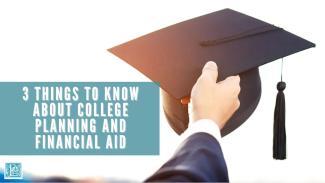
3 Things to Know about College Planning and Financial aid
Planning how to pay for the expenses of attending college or a technical school is essential, and there are ways to save to make secondary education more affordable. Here are three things to know about secondary education planning and financial aid:
What do you need to know about FAFSA filing?
If you or your child will require financial aid to help pay for college or a technical school, you must submit the Free Application for Federal Student Aid (FAFSA) form. The form will become available on StudentAid.gov on October 1, 2021, and you should plan to complete it as soon as possible. Gather these items ahead of time to make completing the form a breeze:
1. Your FSA account credentials after submitting the Free application form
2. 2019 tax records
3. Social security number
4. Driver’s license number
What types of financial aid is available?
A variety of financial aid sources are available to help pay for college or technical school. Finding the right option for you can sound daunting, but here are some financial aid options to keep in mind: · Grants: A grant is a form of financial aid that typically does not need to be repaid. Various federal grants are available, including Pell Grants, Federal Supplemental Educational Opportunity Grants (FSEOG), and Teacher Education Assistance for College and Higher Education (TEACH) Grants. Your state may also offer grants if attending college or trade school in-state.
· Scholarships: Many nonprofit and private organizations offer scholarships to help students pay for secondary education. This type of assistance which bases on academic merit, talent, or a particular area of study, can make a real difference in helping you manage your education expenses.
· Work-Study Jobs: The government provides a Federal Work-Study Program, which allows students to earn money to pay for school by working part-time throughout their studies.
· Loans: Student loans borrow money from the government or a private entity to attend a college or technical school. You must repay the loan as well as any interest that accrues. It is important to understand your repayment options early so you can successfully repay what you owe.
What are some ways to have less financial aid debt?
When heading to college or technical school, it’s a good idea to consider ways to minimize student debt. First, exhaust every option in which you can receive free money to go toward tuition. Research grants and scholarships you may qualify for, and submit the necessary application requirements before the due date.
Save as much money as possible before starting college or technical school. Every dollar you save beforehand is one less dollar that you will need to borrow. And less money borrowed means less interest accruing, so save, save, save!
Consider attending a less expensive school. The more expensive school that you’re planning to attend may seem like a good idea, but choosing a less expensive school can save you money in the long run. Enrolling at an in-state public college or technical school can still provide a high-quality education for less.
Use this information to help you take charge of your education and make the best decision for your unique financial situation. Your financial professional may also provide you with additional information to help you decide on planning for and accepting financial assistance.
Important Disclosures:
The opinions voiced in this material are for general information only and are not intended to provide specific advice or recommendations for any individual.
All information is believed to be from reliable sources; however LPL Financial makes no representation as to its completeness or accuracy.
LPL Tracking # 1-05193191

